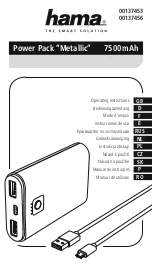
11
Improper connection of the equipment-grounding
conductor can result in a risk of electric shock. The
conductor with insulation having an outer surface
that is green with or without yellow stripes is the
equipment-grounding conductor. If repair or
replacement of the electric cord or plug is
necessary, do not connect the equipment-
grounding conductor to a live terminal.
Check with a qualified
electrician or service personnel if the
grounding instructions are not completely
understood, or if in doubt as to whether the
tool is properly grounded. Failure to comply
may cause serious or fatal injury.
Use only 3-wire extension cords that have 3-prong
grounding plugs and 3-pole receptacles that accept
the tool's plug.
Repair or replace damaged or worn cord
immediately.
2. Grounded, cord-connected tools intended for
use on a supply circuit having a nominal rating
less
than 150
volts:
This tool is intended for use on a circuit that has an
outlet that looks like the one illustrated in
A,
Figure
12. An adapter, shown in
B
and
C
, may be used to
connect this plug to a 2-pole receptacle as shown
in
B
if a properly grounded outlet is not available.
The temporary adapter should be used only until a
properly grounded outlet can be installed by a
qualified electrician.
This adapter is not permitted
in Canada.
The green-colored rigid ear, lug, and
the like, extending from the adapter must be
connected to a permanent ground such as a
properly grounded outlet box.
Figure 12
3. Grounded, cord-connected tools intended for
use on a supply circuit having a nominal rating
between
150 - 250 volts
, inclusive:
This tool is intended for use on a circuit that has an
outlet that looks like the one illustrated in
D,
Figure
12. The tool has a grounding plug that looks like
the plug illustrated in
D
. Make sure the tool is
connected to an outlet having the same
configuration as the plug. No adapter is available
or should be used with this tool. If the tool must be
reconnected for use on a different type of electric
circuit, the reconnection should be made by
qualified service personnel; and after reconnection,
the tool should comply with all local codes and
ordinances.
7.2
Voltage conversion
If 230V operation is desired, the following
instructions must be performed:
1. Disconnect machine from power source.
2. The drill press motor has four leads that are
factory connected for 115V operation. For
230V operation, reconnect the leads as shown
in diagram inside motor junction box cover.
Diagrams are also shown in
section 14.0
of
this manual. (In case of discrepancy, diagram
inside junction box should take precedence.)
3. The 115V attachment plug supplied with the
drill press must be replaced with a UL/CSA
listed plug suitable for 230V operation, similar
to the plug illustrated in D, Figure 12. Contact
your local authorized Powermatic Service
Center or qualified electrician for proper
procedures to install the plug.
4. The drill press must comply with all local and
national codes after the 230-volt plug is
installed.
7.3
Extension cords
The use of extension cords is discouraged; try to
position equipment near the power source. If an
extension cord becomes necessary, be sure to use
one heavy enough to carry the current your product
will draw. An undersized cord will cause a drop in
line voltage resulting in loss of power and
overheating. Table 1 shows correct size to use
depending on cord length and nameplate ampere
rating. If in doubt, use the next heavier gauge. The
smaller the gauge number, the heavier the cord.
Ampere
Rating
Volts
Total length of cord in feet
More
Than
Not
More
Than
120
240
25
50
50
100
100
200
150
300
AWG
0
0
0
6
18
16
16 14
0
6 10
18
16
14 12
10 12
16
16
14 12
12 16
14
12
Not
Recommended
Extension Cord Recommendations
Table 1










































